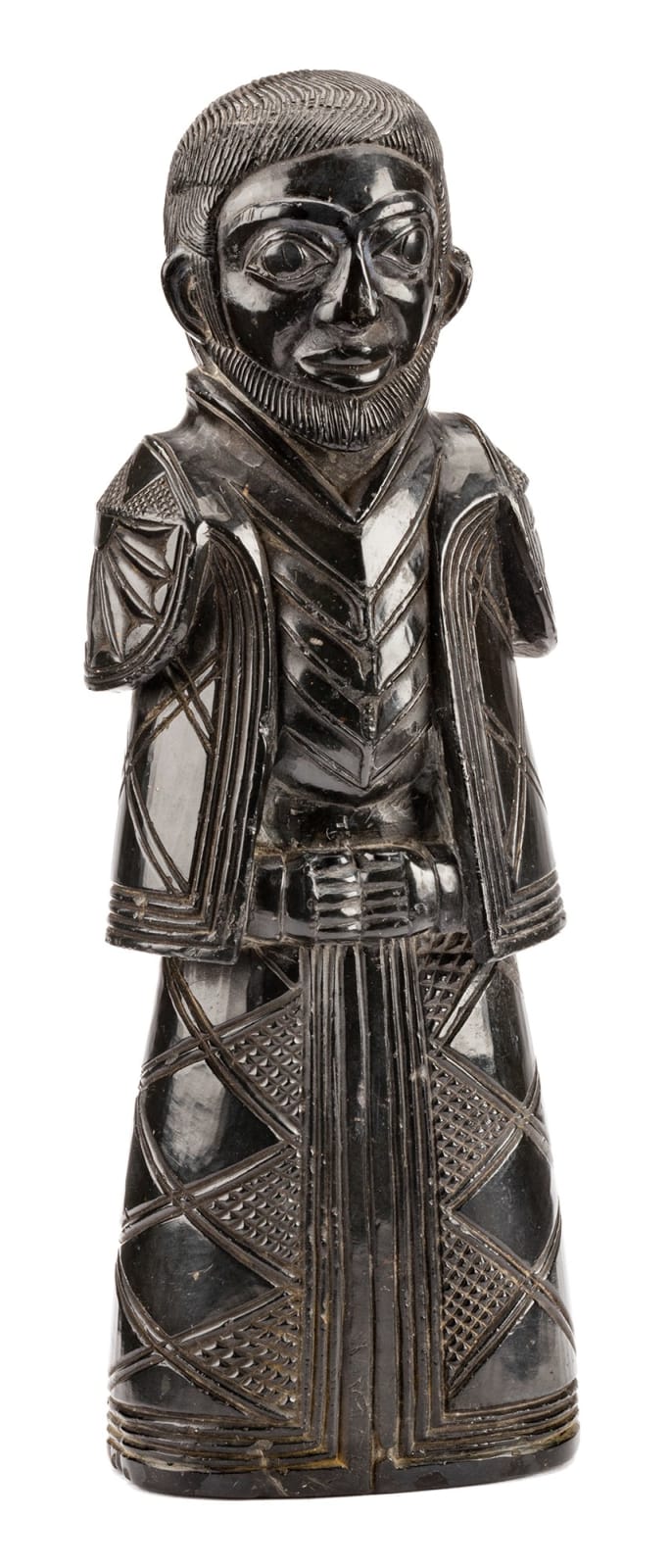-
Artworks
UNIDENTIFIED HAIDA ARTIST
Russian Orthodox Priest, c. 1880 or earlierargillite, 7 x 2.5 x 2 in (17.8 x 6.3 x 5.1 cm)LOT 23
ESTIMATE: $7,000 — $10,000
PRICE REALIZED: $10,800.00Further images
Haida argillite carvers have created images of foreigners almost since the beginning of the slate-carving tradition. Statuettes of American and British sea-captains and sailors, Protestant clergy in their vestments, well-dressed...Haida argillite carvers have created images of foreigners almost since the beginning of the slate-carving tradition. Statuettes of American and British sea-captains and sailors, Protestant clergy in their vestments, well-dressed Victorian ladies and others have manifested the artists’ impressions, often somewhat comical, of the newcomers to the region and their foreign occupations. Carvings of Orthodox Catholic churchmen, on the other hand, are extremely rare. They were probably seldom, if ever, seen outside of Sitka, where the Russian Orthodox church held sway; otherwise, there were almost no opportunities to encounter a fully dressed priest from this denomination. Russian America Company policies toward the Tlingits, whose land they occupied, did not extend to the proselytizing and sweeping assimilation pressures of the Protestant church of Canada. They in many ways left the Tlingits to pursue their own culture and enjoined those who wished to follow Orthodox ways to do so.
An interesting historical case developed in the village of Old Kasaan on Prince of Wales Island, where a European trader named Baronovich was married to the daughter of a high-ranking Haida house leader known as Skowal. A forty-four-foot totem pole was carved to commemorate the occasion. Figures on the pole included a bearded Baronovich, the archangel Michael, a Haida style eagle at the top (the only Haida image), complex foliate borders on each side and a richly robed Orthodox priest. The priest crosses his arms in the manner of one conducting the ritual of communion and Eucharistic service.
The Skowal pole was carved and erected in 1880, and the priest has been said to commemorate Skowal’s journey to Sitka, most likely for his daughter’s wedding, and where he may have taken up the Orthodox faith, as some stories have told. (Alternative interpretations have included the priest as an object of ridicule for attempting to convert the Indigenous, but this seems like a more recent attempt at re-telling the story. A priest as an object of ridicule would most likely not be so elaborately and accurately represented).
It’s possible that this argillite priest may have been associated with the story of the Skowal pole, where another bearded and robed priest was represented in a Haida village. This would suggest a c.1880 date for the argillite carving. It’s also possible that the sculpture was from an earlier time when argillite carvers were regularly creating caricatures of foreign visitors to their shores.The priest wears an elaborate cloak and tunic. His cloak is decorated with fancy epaulets and the back panel with foliate design; his tunic is diamond-patterned. The underside of the sculpture is carved to reveal the bottoms of his shoes and the hem of his tunic. The priest’s features are well-defined and portrait-like, his hair and beard well-coiffed and very finely detailed. His small hands are clasped together at the front of his cloak.
Steven C. Brown
References: For a discussion of more typical argillite Euro-American figure sculptures see Peter L. Macnair and Alan J. Hoover, The Magic Leaves: A History of Haida Argillite Carving, (Victoria: Royal British Columbia Museum, 1984/2002), pp. 79-87. See also Leslie Drew and Douglas Wilson, Argillite: Art of the Haida, (Vancouver: Hancock House Ltd., 1980), p. 189-199 and elsewhere.Provenance
Private Collection, Montreal.
Join our mailing list
* denotes required fields
We will process the personal data you have supplied in accordance with our privacy policy (available on request). You can unsubscribe or change your preferences at any time by clicking the link in our emails.










